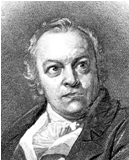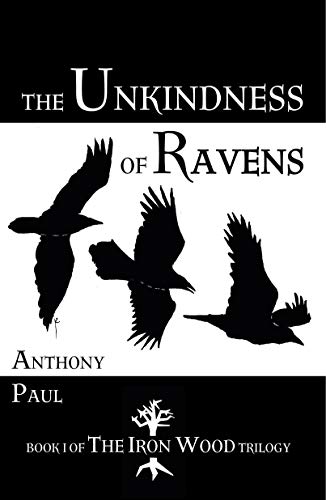Songs of Innocence and Experience by William Blake
Page 7 of 18 - 1 2 3 4 5 6 7 8 9 10 11 12 13 14 15 16 17 18 Purchase full notes for £5.95 (aprox $9.28)
The illustration, furthermore, is notable for its balance and harmony (the figures seem to mirror each other, particularly the man in blue and the woman in olive green).
The text is also surprisingly complex. It begins by evoking the ‘green woods,’ full of associations with Merry Old England and Robin Hood’s Merry Men. The laughing characters of the illustration make it easy to overlook the fact that it is various natural phenomena that are actually laughing – and this is a somewhat strange concept: the ‘green woods,’ the ‘dimpling stream’ and even ‘the air’ are laughing. The ‘dimpling stream’ is not just a poeticism, describing the fast flow of water, but it also references the fact that people’s faces dimple when they laugh.
The young Wordsworth and Coleridge would have seen nature as the source of man’s joy, fulfilment and indeed morality, but Blake sees nature differently. It is the echoing green : nature reflects our laughter and joy and augments it, but it is not the source: the source, as universally in Blake, is in the ‘human brain.’ To one person’s ear, the grasshopper’s chirrup can sound tuneless and ghostly, but to Blake’s ear it is laughter. The laughing girls (‘Mary and Susan and Emily’) become seemingly identical with the ‘painted birds…in the shade,’ and their table is filled with rural fare (‘cherries and nuts’) that would do for finches and warblers as well as humans. Several birds (including the golden bird that is a motif in many of the ‘innocence’ illustrations) are drawn under the text as if to underline this identification, and presumably suggest the ability of the laughing soul to soar to heaven.
The Little Black Boy
These two plates form a symmetry, with the second illustration occupying the same space as the text on the first plate, and the first illustration occupying the same space as the text on the second. This compositional arrangement is also used in The Ecchoing Green , but here the symmetry is carried further: in the first illustration a black mother leans down towards her black child with her back to a tree facing right; in the companion picture, Christ (in white) also leans against a tree, leaning down towards two white children, but facing left. Water is present in both illustrations – in the background of the first and in the foreground of the second. One illustration, therefore appears as the mirror image of the second. The tree is a familiar innocence symbol of stability and security (frequently associated with maternal or paternal figures); here it has the additional function of providing cool shade in the heat of the day (as the black boy will shield the white boy).
The text is also surprisingly complex. It begins by evoking the ‘green woods,’ full of associations with Merry Old England and Robin Hood’s Merry Men. The laughing characters of the illustration make it easy to overlook the fact that it is various natural phenomena that are actually laughing – and this is a somewhat strange concept: the ‘green woods,’ the ‘dimpling stream’ and even ‘the air’ are laughing. The ‘dimpling stream’ is not just a poeticism, describing the fast flow of water, but it also references the fact that people’s faces dimple when they laugh.
The young Wordsworth and Coleridge would have seen nature as the source of man’s joy, fulfilment and indeed morality, but Blake sees nature differently. It is the echoing green : nature reflects our laughter and joy and augments it, but it is not the source: the source, as universally in Blake, is in the ‘human brain.’ To one person’s ear, the grasshopper’s chirrup can sound tuneless and ghostly, but to Blake’s ear it is laughter. The laughing girls (‘Mary and Susan and Emily’) become seemingly identical with the ‘painted birds…in the shade,’ and their table is filled with rural fare (‘cherries and nuts’) that would do for finches and warblers as well as humans. Several birds (including the golden bird that is a motif in many of the ‘innocence’ illustrations) are drawn under the text as if to underline this identification, and presumably suggest the ability of the laughing soul to soar to heaven.
The Little Black Boy
These two plates form a symmetry, with the second illustration occupying the same space as the text on the first plate, and the first illustration occupying the same space as the text on the second. This compositional arrangement is also used in The Ecchoing Green , but here the symmetry is carried further: in the first illustration a black mother leans down towards her black child with her back to a tree facing right; in the companion picture, Christ (in white) also leans against a tree, leaning down towards two white children, but facing left. Water is present in both illustrations – in the background of the first and in the foreground of the second. One illustration, therefore appears as the mirror image of the second. The tree is a familiar innocence symbol of stability and security (frequently associated with maternal or paternal figures); here it has the additional function of providing cool shade in the heat of the day (as the black boy will shield the white boy).

